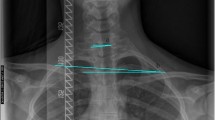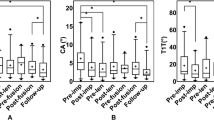Abstract
Objective
To evaluate the relationship between radiological, clinical and perceived shoulder balance (ShB) in a sample of non-operated, moderate, idiopathic scoliosis (IS) patients.
Methods
80 patients (85 % women) with a mean age of 20.3 years (SD 8.6, 12–40 years) were included. Mean Cobb angle was 45.9° (SD 12.9, 25.1°–77.2°). All patients had full spine X-ray and a digital photography from the front. To determine clinical ShB, shoulder height angle (SHA) and axilla height angle (AHA) were measured on clinical photographs. Radiological ShB was assessed with the clavicle–rib intersection angle and T1-tilt. Patients also completed different patient-reported outcomes (PRO) instruments: SRS-22, TAPS and Spinal Appearance Questionnaire (SAQ). SAQ included two questions concerning the shoulder area (SAQ-6 = perception and SAQ-13 = expectation) which were used to assess perceived ShB. Patients were divided into two groups: balanced (SHA <3.0°), and imbalanced (SHA ≥3.0°) according to minimal detectable change of SHA. The correlations between variables and mean differences between the two groups were analyzed.
Results
No statistically significant correlations were found between clinical (SHA and AHA) and perceived ShB (SAQ-6), or with PRO scores. 62.5 % of patients were in the “Balanced” group. 46.6 % (14/30) of patients in the clinically imbalanced group (≥3.0°) perceive themselves as totally balanced (score 1 and 2 in SAQ-6), while 10 % (5/50) of patients in the balanced group (SHA <3.0°) perceive themselves as totally imbalanced (score 4 and 5 in SAQ-13). No differences were found between both groups in terms of radiological and perceived ShB, or in PRO scores.
Conclusion
We have not found a significant correlation between clinical/radiological ShB and perceived ShB in non-operated IS patients. It seems that ShB is not a key factor in patient trunk deformity perception. In addition, patient expectations regarding improvement with treatment are not directly related to actual clinical imbalance.


Similar content being viewed by others
References
Raso VJ, Lou E, Hill DL, Mahood JK, Moreau MJ, Durdle NG (1998) Trunk distortion in adolescent idiopathic scoliosis. J Pediatr Orthop 18:222–226
Kuklo TR, Lenke LG, Graham EJ, Won DS, Sweet FA, Blanke KM, Bridwell KH (2002) Correlation of radiographic, clinical, and patient assessment of shoulder balance following fusion versus non-fusion of the proximal thoracic curve in adolescent idiopathic scoliosis. Spine 27:2013–2020
Pratt RK, Burwell RG, Cole AA, Webb JK (2002) Patient and parental perception of adolescent idiopathic scoliosis before and after surgery in comparison with surface and radiographic measurements. Spine 27:1543–1550 (discussion 1551–1552)
Hong JY, Suh SW, Yang JH, Park SY, Han JH (2013) Reliability analysis of shoulder balance measures: comparison of the 4 available methods. Spine (Phila Pa 1976) 38:E1684–E1690. doi:10.1097/BRS.0b013e3182a18486
Yang S, Jones-Quaidoo SM, Eager M, Griffin JW, Reddi V, Novicoff W, Shilt J, Bersusky E, Defino H, Ouellet J, Arlet V (2011) Right adolescent idiopathic thoracic curve (Lenke 1 A and B): does cost of instrumentation and implant density improve radiographic and cosmetic parameters? Eur Spine J 20:1039–1047. doi:10.1007/s00586-011-1808-4
X-s Qiu, W-w Ma, W-g Li, Wang B, Yu Y, Z-z Zhu, B-p Qian, Zhu F, Sun X, Ng BKW, Cheng JCY, Qiu Y (2009) Discrepancy between radiographic shoulder balance and cosmetic shoulder balance in adolescent idiopathic scoliosis patients with double thoracic curve. Eur Spine J 18:45–51. doi:10.1007/s00586-008-0833-4
Ono T, Bastrom TP, Newton PO (2012) Defining 2 components of shoulder imbalance: clavicle tilt and trapezial prominence. Spine 37:E1511–E1516. doi:10.1097/BRS.0b013e31826e2bbb
Matamalas A, Bago J, D’Agata E, Pellise F (2014) Reliability and validity study of measurements on digital photography to evaluate shoulder balance in idiopathic scoliosis. Scoliosis 9:23. doi:10.1186/s13013-014-0023-6
Sanders JO, Harrast JJ, Kuklo TR, Polly DW, Bridwell KH, Diab M, Dormans JP, Drummond DS, Emans JB, Johnston CE 2nd, Lenke LG, McCarthy RE, Newton PO, Richards BS, Sucato DJ (2007) The Spinal Appearance Questionnaire: results of reliability, validity, and responsiveness testing in patients with idiopathic scoliosis. Spine 32:2719–2722. doi:10.1097/BRS.0b013e31815a5959
Carreon LY, Sanders JO, Polly DW, Sucato DJ, Parent S, Roy-Beaudry M, Hopkins J, McClung A, Bratcher KR, Diamond BE (2011) Spinal appearance questionnaire: factor analysis, scoring, reliability, and validity testing. Spine 36:E1240–E1244. doi:10.1097/BRS.0b013e318204f987
Matamalas A, Bago J, D’Agata E, Pellise F (2014) Body image in idiopathic scoliosis: a comparison study of psychometric properties between four patient-reported outcome instruments. Health Qual Life Outcomes 12:81. doi:10.1186/1477-7525-12-81
Bagó J, Carrera L, March B, Villanueva C (1996) Four radiological measures to estimate shoulder balance in scoliosis. J Pediatr Orthop B 5:31–34
Bago J, Climent JM, Ey A, Perez-Grueso FJS, Izquierdo E (2004) The Spanish version of the SRS-22 patient questionnaire for idiopathic scoliosis: transcultural adaptation and reliability analysis. Spine 29:1676–1680
Bago J, Sanchez-Raya J, Perez-Grueso FJS, Climent JM (2010) The Trunk Appearance Perception Scale (TAPS): a new tool to evaluate subjective impression of trunk deformity in patients with idiopathic scoliosis. Scoliosis 25;5:6. doi:10.1186/1748-7161-5-6
Asher M, Min Lai S, Burton D, Manna B (2003) Discrimination validity of the scoliosis research society-22 patient questionnaire: relationship to idiopathic scoliosis curve pattern and curve size. Spine 28:74–78. doi:10.1097/01.brs.0000047636.95839.f5
Landis JR, Koch GG (1977) The measurement of observer agreement for categorical data. Biometrics 33:159–174
Beaton DE (2000) Understanding the relevance of measured change through studies of responsiveness. Spine (Phila Pa 1976) 25:3192–3199
Lenke LG, Betz RR, Harms J, Bridwell KH, Clements DH, Lowe TG, Blanke K (2001) Adolescent idiopathic scoliosis: a new classification to determine extent of spinal arthrodesis. J Bone Joint Surg Am 83-A:1169–1181
Iwahara T, Imai M, Atsuta Y (1998) Quantification of cosmesis for patients affected by adolescent idiopathic scoliosis. Eur Spine J 7:12–15
Theologis TN, Jefferson RJ, Simpson AH, Turner-Smith AR, Fairbank JC (1993) Quantifying the cosmetic defect of adolescent idiopathic scoliosis. Spine 18:909–912
Ilharreborde B, Even J, Lefevre Y, Fitoussi F, Presedo A, Souchet P, Pennecot GF, Mazda K (2008) How to determine the upper level of instrumentation in Lenke types 1 and 2 adolescent idiopathic scoliosis: a prospective study of 132 patients. J Pediatr Orthop 28:733–739. doi:10.1097/BPO.0b013e318185a36b
Smyrnis PN, Sekouris N, Papadopoulos G (2009) Surgical assessment of the proximal thoracic curve in adolescent idiopathic scoliosis. Eur Spine J 18:522–530. doi:10.1007/s00586-009-0902-3
Bridwell KH, Shufflebarger HL, Lenke LG, Lowe TG, Betz RR, Bassett GS (2000) Parents’ and patients’ preferences and concerns in idiopathic adolescent scoliosis: a cross-sectional preoperative analysis. Spine (Phila Pa 1976) 25:2392–2399
Sanders JO, Carreon LY, Sucato DJ, Sturm PF, Diab M (2010) Preoperative and perioperative factors effect on adolescent idiopathic scoliosis surgical outcomes. Spine (Phila Pa 1976) 35:1867–1871. doi:10.1097/BRS.0b013e3181efa6f5
Sanders JO, Polly DW Jr, Cats-Baril W, Jones J, Lenke LG, O’Brien MF, Stephens Richards B, Sucato DJ (2003) Analysis of patient and parent assessment of deformity in idiopathic scoliosis using the Walter Reed Visual Assessment Scale. Spine 28:2158–2163. doi:10.1097/01.BRS.0000084629.97042.0B
Bago J, Climent JM, Pineda S, Gilperez C (2007) Further evaluation of the Walter Reed Visual Assessment Scale: correlation with curve pattern and radiological deformity. Scoliosis 2:12. doi:10.1186/1748-7161-2-12
Yang S, Feuchtbaum E, Werner BC, Cho W, Reddi V, Arlet V (2012) Does anterior shoulder balance in adolescent idiopathic scoliosis correlate with posterior shoulder balance clinically and radiographically? Eur Spine J 21:1978–1983. doi:10.1007/s00586-012-2434-5
Akel I, Pekmezci M, Hayran M, Genc Y, Kocak O, Derman O, Erdoğan I, Yazici M (2008) Evaluation of shoulder balance in the normal adolescent population and its correlation with radiological parameters. Eur Spine J 17:348–354. doi:10.1007/s00586-007-0546-0
Fortin C, Ehrmann Feldman D, Cheriet F, Labelle H (2013) Differences in standing and sitting postures of youth with idiopathic scoliosis from quantitative analysis of digital photographs. Phys Occup Ther Pediatr. doi:10.3109/01942638.2012.747582
Fortin C, Feldman DE, Cheriet F, Gravel D, Gauthier F, Labelle H (2012) Reliability of a quantitative clinical posture assessment tool among persons with idiopathic scoliosis. Physiotherapy 98:64–75. doi:10.1016/j.physio.2010.12.006
Acknowledgments
This research was supported by a research grant from Biomet/Justimplant and the Spanish Spine Society (GEER).
Conflict of interest
The authors have no competing interests to declare.
Author information
Authors and Affiliations
Corresponding author
Rights and permissions
About this article
Cite this article
Matamalas, A., Bagó, J., D’Agata, E. et al. Does patient perception of shoulder balance correlate with clinical balance?. Eur Spine J 25, 3560–3567 (2016). https://doi.org/10.1007/s00586-015-3971-5
Received:
Revised:
Accepted:
Published:
Issue Date:
DOI: https://doi.org/10.1007/s00586-015-3971-5




